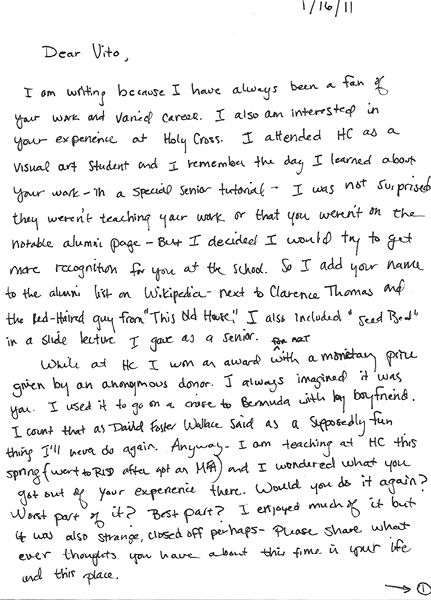
LETTERS TO VITO
first performed on
October 5, 2011
Cantor Art Gallery, College of the Holy Cross, Worcester, MA
performed once in 2011
RACHELLE BEAUDOIN
New Hampshire
706275949r706275949a706275949c706275949h706275949e706275949l706275949l706275949e706275949.706275949b706275949e706275949a706275949u706275949d706275949o706275949i706275949n706275949@706275949g706275949m706275949a706275949i706275949l706275949.706275949c706275949o706275949m
rachellebeaudoin.com
LETTERS TO VITO
RACHELLE BEAUDOIN
“Letters to Vito” is a live reading of 20 letters I have written to Vito Acconci since January of 2011. Beginning upon my return to our shared alma mater, Holy Cross, the letters explore our connection to each other, pose questions about art making, process and the art world, and serve as space for my own ramblings and musings.
The letters were written, scanned, and mailed to Acconci. The copies were then read out loud, in order, at Holy Cross in the Cantor Art Gallery as a performance. The piece deals with issues related to celebrity as Vito Acconci has achieved notoriety and fame as a performance artist and architect but is not well known at his own alma mater. The type of prominence he has achieved is different than that of tabloid starlets in that he is not known to the larger population. But, in the art world, his fame operates in a similar way. There is a mythology surrounding him and it is not uncommon to know others who know him, have worked with him, or have some connection to him, making him seem familiar and our relationship, though invented, seem probable.
The work is a part of a continued investigation into my relationship and connection to the idea of the famous male artist. As a young female artist, I have known and been taught the work male artists and encounter it as the standard to which other work should be compared. Although female artists are gaining recognition, white male artists are still hailed and exalted as geniuses in the field. This work is part of an ongoing series in which I explore the complex relationship between my own work and the work of Bruce Nauman, Cory Arcangel, and Acconci. As I produce work about them, I am using their celebrity for my own benefit and trying to gain access to the world where they have achieved success and fame. Ultimately, the piece deals with a failure to connect and to know the true Acconci because, despite my correspondence, openness, and hopeful letters, he has not responded and did not accept my invitation to visit Holy Cross to attend the performance. This is highlighted by a moment in the performance, when I read a letter stating that I am waiting for him to walk in the door. I pause, wait, look towards the door and he does not appear.